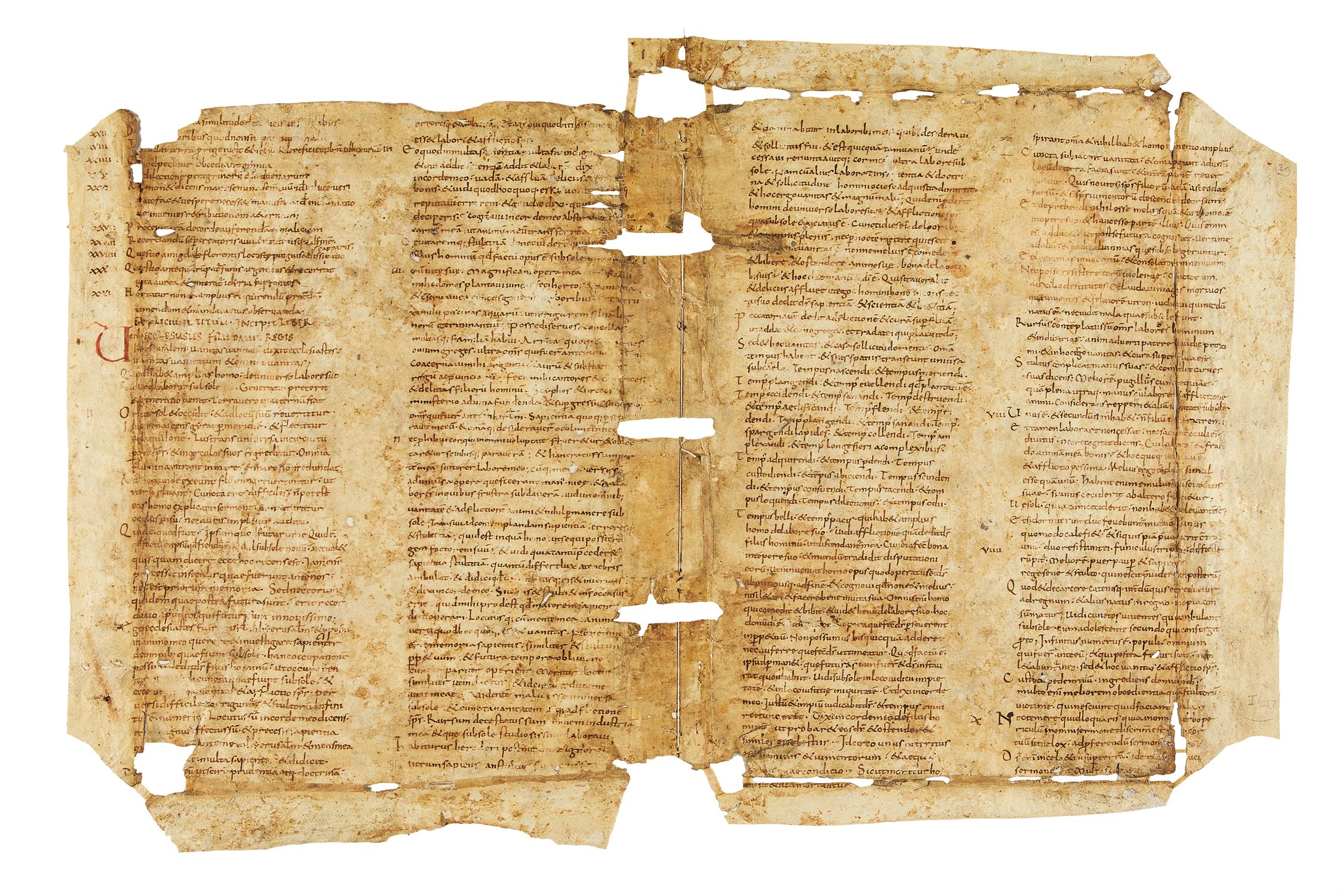Carolingian Bible, in Latin, on parchment [probably France, first half of the ninth century] Top half of a leaf, with remains of double column, 24 lines in a fine early Carolingian minuscule with an open ‘a’ with righthand leaning uppermost strokes, an open ‘e’ which leans dramatically to the right, and a capital ‘L’ with hairline capstrokes on both ends, written with a thin nibbed pen in tiny letters, original running title “Lib[er] / Isaiae” in ornamental capitals, later chapter numbers (perhaps eleventh century), other marginalia with textual references, trimmed at one side with loss of border and approximately 14 characters from one column and about 24 lines from the base, thus original written space of approximately 280mm. by 210mm. and original leaf size of approximately 310mm. by 240mm., recovered from a binding and with small stains, smudges, holes and tears to edges, but good and legible condition, 212mm. by 175mm. Provenance: From a group of leaves evidently sold by Charles Hamilton Jr. (1914-96) to a now-deceased American collector. Text: The Carolingian revival of the notion of Europe as a single political unit could not look to a single language, lawcode or ethnic group to justify its existence, and instead the earliest scholars of the courts of Charlemagne and his immediate heirs turned to religion to unify it. In 789, Charlemagne called in his Admonitio Generalis for the protection of the surviving manuscripts of the Bible from wanton destruction, and he ordered that only trusted and mature scribes were to undertake its copying. The production of the vast and uniform Tours Bibles produced under the watchful eye of Alcuin (c.740-804) and the script-reform that their dissemination brought about, is now well known (see D. Ganz in The Early Medieval Bible, 1994; and the fragment of the Tours Bible with parts of Ezekiel, sold in the Schoyen sale at Sotheby’s, 10 July 2012, lot 28, for £31,250). However, it is clear that a handful of other centres also responded to Charlemagne's call for corrected Biblical books. In southern France, Theodulf of Orleans (c.750/60-821) produced an entire Bible text, and another attempt from the imperial scriptorium of Lorsch (probably limited to a number of Old Testament books) is recorded in the library catalogue of that house and survives in a single fragment of Tobit, again from a binding (sold Sotheby’s, 10 July 2012, lot 29, for £93,650; see also R. McKitterick in The Library, 6th series, 12, 1990, p.31). This fragment here is clearly not in the rolling and rotund script of Tours and does not conform to the rigid set of measurements of Tours Bibles, and is most probably the sole surviving relic of another attempt to produce an accurate Old Testament text, perhaps in another monastic house under imperial patronage. The text here is Isaiah 56:12-57:10 and 57:21-58:8 (obverse), and 59:2-11 and 59:19-60:6 (reverse).
Carolingian Bible, in Latin, on parchment [probably France, first half of the ninth century] Top half of a leaf, with remains of double column, 24 lines in a fine early Carolingian minuscule with an open ‘a’ with righthand leaning uppermost strokes, an open ‘e’ which leans dramatically to the right, and a capital ‘L’ with hairline capstrokes on both ends, written with a thin nibbed pen in tiny letters, original running title “Lib[er] / Isaiae” in ornamental capitals, later chapter numbers (perhaps eleventh century), other marginalia with textual references, trimmed at one side with loss of border and approximately 14 characters from one column and about 24 lines from the base, thus original written space of approximately 280mm. by 210mm. and original leaf size of approximately 310mm. by 240mm., recovered from a binding and with small stains, smudges, holes and tears to edges, but good and legible condition, 212mm. by 175mm. Provenance: From a group of leaves evidently sold by Charles Hamilton Jr. (1914-96) to a now-deceased American collector. Text: The Carolingian revival of the notion of Europe as a single political unit could not look to a single language, lawcode or ethnic group to justify its existence, and instead the earliest scholars of the courts of Charlemagne and his immediate heirs turned to religion to unify it. In 789, Charlemagne called in his Admonitio Generalis for the protection of the surviving manuscripts of the Bible from wanton destruction, and he ordered that only trusted and mature scribes were to undertake its copying. The production of the vast and uniform Tours Bibles produced under the watchful eye of Alcuin (c.740-804) and the script-reform that their dissemination brought about, is now well known (see D. Ganz in The Early Medieval Bible, 1994; and the fragment of the Tours Bible with parts of Ezekiel, sold in the Schoyen sale at Sotheby’s, 10 July 2012, lot 28, for £31,250). However, it is clear that a handful of other centres also responded to Charlemagne's call for corrected Biblical books. In southern France, Theodulf of Orleans (c.750/60-821) produced an entire Bible text, and another attempt from the imperial scriptorium of Lorsch (probably limited to a number of Old Testament books) is recorded in the library catalogue of that house and survives in a single fragment of Tobit, again from a binding (sold Sotheby’s, 10 July 2012, lot 29, for £93,650; see also R. McKitterick in The Library, 6th series, 12, 1990, p.31). This fragment here is clearly not in the rolling and rotund script of Tours and does not conform to the rigid set of measurements of Tours Bibles, and is most probably the sole surviving relic of another attempt to produce an accurate Old Testament text, perhaps in another monastic house under imperial patronage. The text here is Isaiah 56:12-57:10 and 57:21-58:8 (obverse), and 59:2-11 and 59:19-60:6 (reverse).
.jpg)


.jpg)
.jpg?w=400)

.jpg)
.jpg)




Try LotSearch and its premium features for 7 days - without any costs!
Be notified automatically about new items in upcoming auctions.
Create an alert